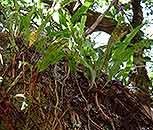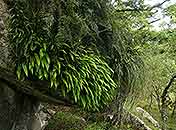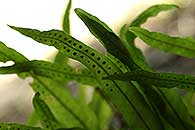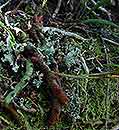Lepisorus excavatus (Willd.) Ching
Synonyms |
Pleopeltis excavata (Bory ex Willd.) Sledge |
|---|---|
Common name |
|
Description |
Rhizome widely creeping, up to 5 mm in diameter, with a whitish, waxy covering; rhizome scales shiny, brown, lanceolate to narrowly ovate in outline, up to 4 mm long, apex pointed, margins paler, subentire. Fronds spaced apart (4-12 mm), erect, membranous, deciduous. Stipe up to 9 cm long, strawcoloured to yellowish, with a few scattered, small brown scales when young. Lamina up to 35(-47) × 4 cm, narrowly lanceolate to narrowly olong-linear, apex gradually tapering to a point or rounded, base narrowly wedge-shaped, margins entire to weakly wavy, glabrous on both surfaces or with a few scales when yound, veins rather obscure. Sori round, 2.5-5 mm in diameter at maturity, in a line on either side of the midrib in the upper half of the lamina, exindusiate, sunken and thus creating a slightly raised impression on the upper surface of the lamina. |
Notes | This species can be distinguished from Lepisorus schraderi and Pleopeltis macrocarpa by having a thinly membranous, glabrous, deciduous lamina and a rhizome that has a white, waxy coating. Microgramma mauritiana has sori set on the lower part of the lamina (not the upper) and is glabrous. |
Derivation | excavatus: hollowed out, referring to the sori which are embedded in shallow cavities of the lamina. |
Habitat | Dry forest, mist-forest, moist evergreen forest or in high-altitude rocky outcrops, Brachystegia woodland, tree-heath montane zone, partially or deeply shaded. |
Distribution worldwide | Africa, Comoro Isl., Madagascar, Mauritius, Réunion. |
Distribution in Africa |
Angola, Burundi, Cameroon, Dem. Republic of Congo, Equatorial Guinea (incl. Bioko), Ethiopia, Guinea, Ivory Coast, Kenya, Liberia, Malawi, Mozambique, Nigeria, Rwanda, Sierra Leone, Somalia, South Africa, Sudan and South Sudan, Tanzania , Uganda, Zambia, Zimbabwe. |
Growth form |
Epiphytic, lithophytic. |
Literature |
|






